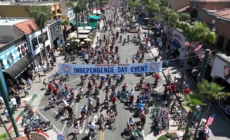-
How the U.S. Captured One of Mexico’s Biggest Drug Lords - 15 mins ago
-
Mets’ Kodai Senga Exits First Start of Season With Injury - 32 mins ago
-
Fresno County man sentenced for sexually assaulting children, dog - 35 mins ago
-
Doused by Rain, Paris Opens Its Games With a Boat Party on the Seine - 59 mins ago
-
How to Watch Men’s Tennis at the 2024 Paris Olympics: Streams, Schedule - about 1 hour ago
-
Photos: Paris is the backdrop for a colorful Olympics opening ceremony - about 1 hour ago
-
NASCAR News: This Is Where Corey LaJoie Could Go After Spire Motorsports Exit - 2 hours ago
-
Bullet or Fragment of One Struck Trump’s Ear, F.B.I. Says - 2 hours ago
-
Violent demonstration outside L.A. synagogue sparks second lawsuit - 2 hours ago
-
Donald Trump’s Protester Comments Raise Key Issues - 2 hours ago
What Would Make the Subway Feel Safer? Experts Have 5 Suggestions.
A string of frightening attacks in the subway amid a broader increase in crime in the system so far this year has put some New Yorkers on edge.
When Gov. Kathy Hochul deployed National Guard members and State Police troopers to the transit system this month, she said her goal was twofold: to fight crime and to make riders feel safe. The subway is crucial to New York’s vitality, and passengers’ needs are a top priority for her and other public officials as they navigate the city’s post-pandemic recovery.
But just days after the reinforcements arrived, a shooting on an A train in Brooklyn underscored how fragile any sense of security can be and undermined officials’ message, supported by data, that the subway is safe. It also stirred a dread familiar to many riders, who have witnessed some of the city’s biggest problems — untreated mental health issues, illegal guns, homelessness — being amplified in the confined spaces of platforms and trains.
Leaders in the fields of transportation, criminal justice and social services often disagree about the best way to make the subway safer, with some calling for more police and others suggesting a softer approach.
Here are five ideas that experts say could help ease riders fears about the subway:
Strengthen gun checks
Some experts believe more must be done to keep guns out of the system.
Rigorous and widespread bag checks, which the police already conduct at random, are an effective way to achieve that goal, said Anastasia Loukaitou-Sideris, the interim dean at U.C.L.A.’s Luskin School of Public Affairs.
Professor Loukaitou-Sideris, who specializes in transit safety, said the Metropolitan Transportation Authority, the state agency that operates the subway, could consider searching riders at every station using metal detectors and X-ray machines. She said that although doing so might be difficult and expensive, the Shanghai Metro does it efficiently.
The authority, she suggested, could also experiment with using sensors to detect guns. Transportation officials around the world have been studying the idea of adding such sensors to fare-collection devices and ticketing machines for some time, as she and several coauthors wrote in a chapter of the 2015 book “Securing Transportation Systems.”
“You have to eliminate the opportunity to bring the gun on the train,” she said.
Professor Loukaitou-Sideris cautioned that any extra screening should affect service as little as possible. And civil libertarians have warned that any more surveillance risks compromising riders’ privacy.
Provide more help for those who need it
Fears about subway safety arise in part from high-profile attacks in which mentally ill homeless people have seemingly targeted riders at random. There is, however, no data to suggest that people with mental illness are more likely to commit violence than those without it. Mentally ill people are actually more likely to be the victim of a violent crime.
A visible presence of social and transit workers can help deter crime and de-escalate tense situations, advocates said.
Some mass transit supporters have urged the M.T.A. to create a more robust internal division for helping homeless people. These advocates cite the agency that operates Philadelphia’s transit system and runs a program that employs about 50 social service outreach specialists. In Philadelphia, homeless people can be directed to the Hub of Hope, a drop-in center within the transit system, that provides showers, medical care and food.
Although the M.T.A. already sends a small number of outreach teams into the subway to move homeless people out of the system, some activists said something like the Hub of Hope could focus on providing a safe, comfortable place for getting help within the system.
“Mental health issues, poverty, trauma — these are all things that we know are drivers of violence,” said Jamila Hodge, the executive director of Equal Justice USA, a national anti-violence organization based in Brooklyn.
Alter the physical environment
Bright lights, see-through staircases and other structural features can make the system feel less claustrophobic.
The M.T.A. has already done some work in this area, announcing last month that it would convert all 150,000 fluorescent light fixtures in the system to LED lighting by the middle of 2026. The project is meant to make riders feel safer and more comfortable. The new fixtures will also help capture better video using the subway’s roughly 15,000 security cameras.
“It’s the safety-in-numbers idea,” said Chris Van Eyken, the director of research and policy at TransitCenter, a research and advocacy group. “There’s also a bit of a deterrent.”
Transportation officials are also experimenting with other structural changes to improve safety and make the system feel more orderly, testing new fare gates to stop turnstile jumpers and metal platform barriers to keep riders from falling onto the tracks.
Help riders be prepared
When something frightening happens in the subway, riders often do not know what to do.
Transit officials in the San Francisco region have sought to help female riders on the Bay Area Rapid Transit, or BART, system avoid harassment with a campaign that teaches bystanders how to assist someone being victimized. Transportation safety leaders say the M.T.A. could adopt a similar program. (The Bay Area campaign focuses on women and girls because they are more likely to be concerned for their safety on public transit than male passengers.)
Advertisements circulated within the BART system encourage people to assess a situation by observing, for instance, whether a harasser has a weapon. Witnesses are urged to approach a victim when they feel it is safe to do so or to otherwise call for help.
The campaign has had promising results. A survey conducted from October through December showed that 7 percent of BART riders had recently experienced gender-based sexual harassment, compared with 10 percent during the same period in 2020, before the campaign began.
But some transit activists warned against encouraging anything that might resemble vigilantism, which they say has led to deadly consequences in the subway.
Danny Pearlstein, a spokesman for the Riders Alliance, an advocacy group in New York, said the rise of social media and high-definition cellphone videos had magnified the perceived scale of violence in the subway. He added that the issue of subway safety had become intertwined with politicized disputes about crime in a way that risked creating an inaccurate portrayal of the system’s overall safety.
Increase fare enforcement
Dorothy Schulz, a retired captain with the Metro-North Police Department and emeritus professor at John Jay College of Criminal Justice, said law enforcement officers should stand at gates and stop people who did not pay the fare.
She echoed complaints by Mayor Eric Adams about “a sense of disorderly behavior,” which some law enforcement officials believe can be a precursor to violent crime.
The M.T.A. has struggled for years to rein in fare evasion, and it has begun considering options other than relying on the police. Left-leaning politicians and advocates for poor New Yorkers have denounced aggressive policing efforts, which they say unfairly target the city’s most vulnerable people and are not effective.
Transit leaders have responded by trying other tactics, including experimenting with increasing fare subsidies, media campaigns urging riders to pay, and new fare gates that are harder to circumvent.
“If you stop people at the fare gates — particularly those who are obviously not intending to pay — you’ll pick up a lot of weapons and a lot of people with warrants,” Ms. Schulz said. “That’s the solution.”


















